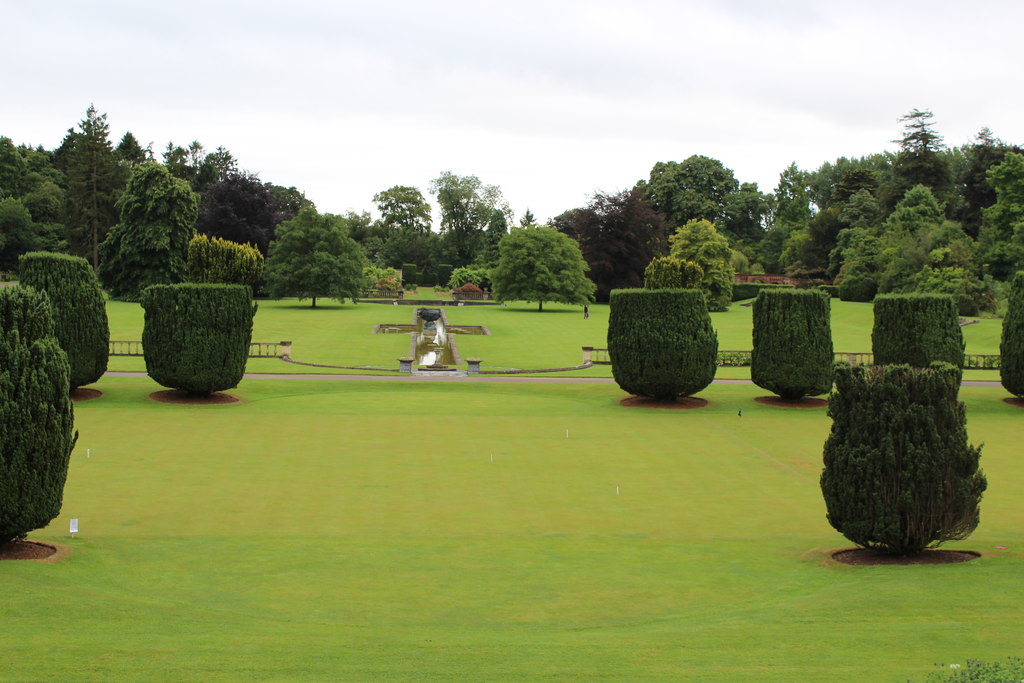Lawn
|
Viewed from the balcony, this croquet lawn runs across the foreground with the Great Lawn and its empty linear pond beyond. Dyffryn Gardens, a National Trust site, is a Grade I listed landscape and gardens. It was designed in 1906 for John Cory and his son Reginald, who was a keen horticulturalist and plant collector. |
Contents |
[edit] Introduction
A lawn can be defined as an area of soil-covered land where grass has been intentionally planted and is regularly maintained, often through the act of mowing. In a general sense, the grass used for landscaping purposes is sometimes called a lawn.
In areas where environmental conditions may not support grass lawns, these areas may be made up of other types of ground coverings, such as clover or moss.
[edit] Lawn characteristics
A lawn is typically situated near to a building. For some people, a lawn represents a bridge between the natural environment and a constructed urban (or suburban) space.
A lawn can also be part of a public park, in particular in cities. One such example is the Great Lawn in Central Park, but there are also great lawns in private gardens.
Some lawns may be used (and cared for) to support specific recreational activities (such as tennis, bowls, croquet, lawn darts and so on). In addition to protecting players from injury, the soft natural surface of a lawn can be used for strategic purposes as part of the competition.
[edit] History
The earliest mention of a lawn as a plot of grassy land dates to the mid-1500s. During this period, lawns were created as enclosures within a community. They served as a place for livestock to graze away from the fields that were used to grow crops.
Lawns later became associated with the aristocracy, as the vast space allowed the owner to observe any visitors from a distance as they approached the property. In this instance, the lawn also served as a method of expressing status, since it could be designed to provide an impressive view of a manor house or estate.
Early lawns were maintained manually with scythes, but livestock was also permitted to graze in certain places. These semi-natural lawns still exist in parts of England and France.
The more formal version of the English lawn became popular in the Jacobean era, when this type of garden was redefined by members of the aristocracy. The semi-natural lawn was replaced by closely cropped grass that almost seemed artificial; this was often adjacent to more natural parkland which was meant to serve as a contrast. This style was imported to the US, where wealthy families quickly adopted the tradition.
[edit] Lawns for the middle class
Over the years, lawns became synonymous with conditions that make it possible to dedicate suitable resources - including time and money - to their care and maintenance. In the late 1930s, a set of labour laws passed in the US gave workers more free time to undertake leisure activities, such as lawn care.
After the Second World War, the lawn gained even more ground in the US and became linked to the growing appeal of suburban living, particularly in planned communities such as Levittown, New York. A carefully manicured lawn became a type of status symbol for some people who wished to project an image associated with elevated social standing.
In some parts of the world (such as the US and Australia), the link between lawns and status continues. Homeowners’ associations in some communities are given the power (through bylaws) to dictate certain exterior conditions. These parameters have been deemed aesthetically acceptable by the majority of residents and can cover aspects such as lawn health and maintenance, including grass height.
[edit] Related articles on Designing Buildings Wiki
Featured articles and news
RTPI leader to become new CIOB Chief Executive Officer
Dr Victoria Hills MRTPI, FICE to take over after Caroline Gumble’s departure.
Social and affordable housing, a long term plan for delivery
The “Delivering a Decade of Renewal for Social and Affordable Housing” strategy sets out future path.
A change to adoptive architecture
Effects of global weather warming on architectural detailing, material choice and human interaction.
The proposed publicly owned and backed subsidiary of Homes England, to facilitate new homes.
How big is the problem and what can we do to mitigate the effects?
Overheating guidance and tools for building designers
A number of cool guides to help with the heat.
The UK's Modern Industrial Strategy: A 10 year plan
Previous consultation criticism, current key elements and general support with some persisting reservations.
Building Safety Regulator reforms
New roles, new staff and a new fast track service pave the way for a single construction regulator.
Architectural Technologist CPDs and Communications
CIAT CPD… and how you can do it!
Cooling centres and cool spaces
Managing extreme heat in cities by directing the public to places for heat stress relief and water sources.
Winter gardens: A brief history and warm variations
Extending the season with glass in different forms and terms.
Restoring Great Yarmouth's Winter Gardens
Transforming one of the least sustainable constructions imaginable.
Construction Skills Mission Board launch sector drive
Newly formed government and industry collaboration set strategy for recruiting an additional 100,000 construction workers a year.
New Architects Code comes into effect in September 2025
ARB Architects Code of Conduct and Practice available with ongoing consultation regarding guidance.
Welsh Skills Body (Medr) launches ambitious plan
The new skills body brings together funding and regulation of tertiary education and research for the devolved nation.
Paul Gandy FCIOB announced as next CIOB President
Former Tilbury Douglas CEO takes helm.
UK Infrastructure: A 10 Year Strategy. In brief with reactions
With the National Infrastructure and Service Transformation Authority (NISTA).























